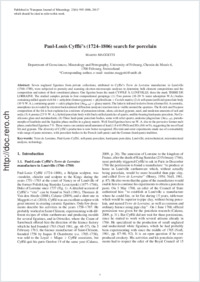Paul-Louis Cyfflé's (1724-1806) search for porcelain
- Maggetti, Marino Department of Geosciences, Mineralogy and Petrography, University of Fribourg, Switzerland
-
01.12.2011
Published in:
- European Journal of Mineralogy. - 2011, vol. 23, no. 6, p. 993-1006
Terre de Lorraine
Paul-Louis Cyfflé
soft-paste porcelain
hard-paste porcelain
Lunéville
microchemical
microstructural analysis
technology
English
Seven unglazed figurines from private collections, attributed to Cyfflé's Terre de Lorraine manufacture in Lunéville (1766-1780), were subjected to porosity and scanning electron microscopic analyses to determine bulk element compositions and the composition and nature of their constituent phases. One figurine bears the mark CYFFLÉ À. LUNÉVILLE, three the mark TERRE DE LORRAINE. The studied samples pertain to four compositional groupings: (1) Two porous (18-20 % water adsorption W.A.) bodies containing milled quartz-rich frit + anhydrite (former gypsum) + phyllosilicate + Ca-rich matrix; (2) A soft-paste (artificial) porcelain body (10 % W.A.), containing quartz + calcic plagioclase (An₈₈₋₉₅) + glassy matrix. The latter is inferred to derive from a former frit. A coronitic, amorphous (as revealed by electron backscattered diffraction analysis) reaction rim is visible around the quartzes. The K-rich and Na-poor composition of the frit is best explained as a mixture of potassium nitrate, alum, calcined gypsum, sand, and moderate amounts of salt and soda; (3) A porous (23 % W.A.), hybrid porcelain body with finely milled particles of quartz, mullite-bearing hard-paste porcelain, Na-Ca-siliceous glass and metakaolinite; (4) Three hard-paste porcelain bodies, some with relict quartz, andesine plagioclase (An₃₇₋₄₅), pseudomorphs of kaolinite and the liquidus phase mullite in a glassy matrix. Well fired figurines have no W.A. due to the pervasive former melt phase, underfired figurines 7 %. These wares can contain small amounts of lead (1.8 wt% PbO) and SO₃ (0.6 wt%), suggesting the use of lead frit and gypsum. The diversity of Cyfflé's production is now better recognized. His trial-and-error experiments made use of a remarkably wide range of paste mixtures, with porcelain bodies in the French (soft-paste) and the German (hard-paste) tradition.
- Faculty
- Faculté des sciences et de médecine
- Department
- Département de Géosciences
- Language
-
- English
- Classification
- Mineralogy
- License
-
License undefined
- Identifiers
-
- RERO DOC 28748
- DOI 10.1127/0935-1221/2011/0023-2155
- Persistent URL
- https://folia.unifr.ch/unifr/documents/302190
Statistics
Document views: 131
File downloads:
- pdf: 209
